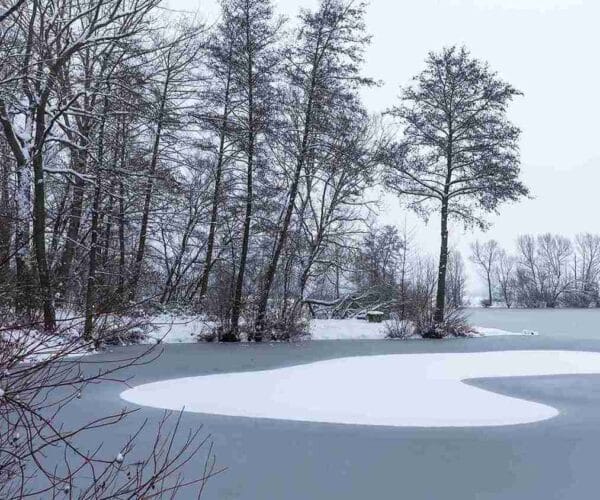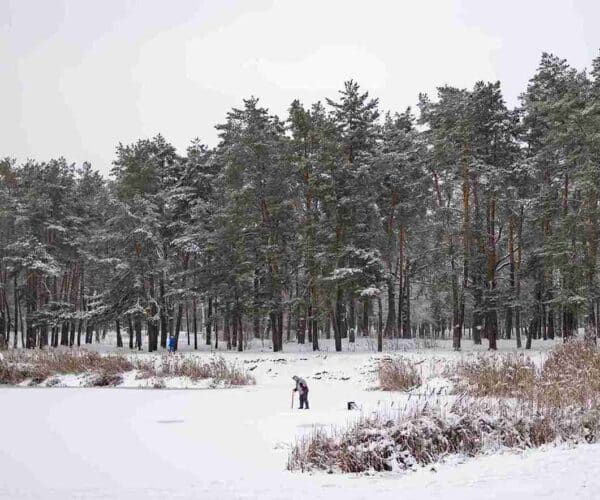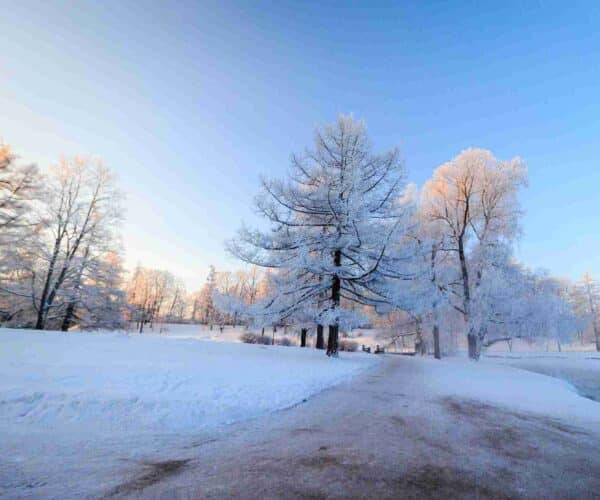When you think of golf, you probably picture a vibrant green course, sunlit fairways, and the satisfying sound of a golf ball soaring through the air. But what if we told you that golf isn’t just for the warmer months? Snow golf is a winter twist on the classic game that’s gaining traction, particularly in colder climates. For golf lovers who aren’t ready to pack up their clubs when the temperature drops, snow golf offers the perfect way to keep playing, even amid the snow.
In this guide, we’ll cover everything you need to know about snow golf – how it’s played, the unique challenges it presents, and the best destinations to try it. We’ll also highlight the differences between traditional golf and snow golf, as well as the rules and equipment needed for a winter golfing experience like no other.
What is snow golf?

Snow golf is essentially the same game as traditional golf, but it’s played on a course that is covered in snow. While the basic objective remains the same, getting the ball from the tee to the hole in as few strokes as possible, snow golf comes with its own unique set of challenges. Players use specially designed equipment to ensure the game is playable in snowy conditions, including brightly coloured golf balls (often in neon shades) to ensure visibility against the white snow.
In snow golf, you may find that the typical fairways are replaced by snow-covered terrain, with obstacles like ice patches, deep snow, and sometimes even snowdrifts that alter the way the ball behaves. Players still aim to complete the 18 holes, but the game often includes additional challenges like the elements of weather and tricky, snowy landscapes.
Where can you play snow golf?

Snow golf is played in a variety of locations around the world, particularly in colder climates where snow is common. You can find snow golf courses in areas like Sweden, Norway, Canada, and parts of the Alps. These destinations host both casual snow golf games and organised snow golf tournaments, offering an exciting twist for golfers who love to play in winter.
In fact, some golf courses in these snowy regions are specifically set up to accommodate snow golf during the winter months. For example, Bardufoss Golf Course in Norway and Jokkmokk Golf Course in Sweden are known for hosting events and tournaments during the winter season. Additionally, some ski resorts and winter sports destinations also offer snow golf as part of their recreational activities.
Here are some of the top golf courses where you can enjoy snow golf during the winter months. These destinations offer unique winter golf experiences, and some host specific snow golf events or have courses designed to accommodate snow-covered fairways:
Bardufoss Gold Course - Norway
Location: Bardufoss, Troms
Why it’s great: This course is known for its spectacular winter events, including snow golf tournaments. The Bardufoss Golf Course in northern Norway is one of the most popular locations to play snow golf, with snowy landscapes offering a true winter golfing challenge. They even have specialised snow golf events in the colder months.
Highlights: The northern location provides stunning snow-covered courses, offering a challenging experience for golfers seeking something different.
Jokkmokk Golf Course – Sweden
Location: Jokkmokk, Sweden
Why it’s great: Known for its northern Swedish charm, the Jokkmokk Golf Course hosts the Swedish Snow Golf Championship. This course is set in Lapland, a region famous for its snowy terrain. Jokkmokk’s snow golf tournaments bring together players from around the world to compete in this unique winter golfing environment.
Highlights: The Swedish Snow Golf Championship and stunning Arctic landscapes offer a true winter adventure for golf lovers.
Zermatt Golf Course – Switzerland
Location: Zermatt, Switzerland
Why it’s great: Located near the famous Matterhorn, Zermatt Golf Course hosts snow golf events during the winter months. The course offers a scenic experience as you play against the backdrop of Switzerland’s snowy Alps. Players use specially designed winter golf balls and equipment to navigate the snow-covered fairways.
Highlights: The picturesque Alps and a long history of hosting winter sports events make Zermatt a top destination for snow golf enthusiasts.
Sölden Golf Course – Austria
Location: Sölden, Austria
Why it’s great: Situated in the Austrian Alps, the Sölden Golf Course offers a stunning winter golf experience. With snowy peaks surrounding the course, snow golf here combines spectacular scenery with a challenging game. They host an annual snow golf tournament called the Sölden Snow Golf Masters.
Highlights: The Alps’ dramatic landscapes provide a breathtaking backdrop for snow golf tournaments and friendly winter golfing.
Banff Springs Golf Course – Canada
Location: Banff, Alberta, Canada
Why it’s great: Nestled in the heart of the Canadian Rockies, the Banff Springs Golf Course is a famous location known for its scenic beauty and winter sports. While it’s not always open for snow golf on a regular basis, the course has hosted special snow golf events during the winter months in collaboration with local resorts.
Highlights: The majestic Rocky Mountains and access to one of Canada’s most picturesque golf resorts make Banff a prime location for winter golfing.
Gstaad Golf Club – Switzerland
Location: Gstaad, Switzerland
Why it’s great: Another Swiss gem, Gstaad Golf Club offers snow golf events during the winter season. Located in the Saanenland region of the Swiss Alps, this club is ideal for golfers who want to combine snow sports with golf. The region’s natural beauty makes it a wonderful winter retreat for golfers.
Highlights: The luxury of the Swiss Alps and a well-maintained course offer a premium snow golf experience.
Torsby Golf Course – Sweden
Location: Torsby, Värmland, Sweden
Why it’s great: The Torsby Golf Course is another location in Sweden that caters to snow golf. Known for its welcoming community and breathtaking surroundings, this course offers a chance to experience snow golf in a tranquil, snowy environment. Torsby’s winter golf events attract visitors looking for a new golfing challenge in the heart of Scandinavia.
Highlights: A relaxed and scenic winter golf experience in one of Sweden’s beautiful, snow-covered regions.
Arctic Golf Club – Finland
Location: Rovaniemi, Finland
Why it’s great: In the home of Santa Claus, the Arctic Golf Club offers a unique winter golfing experience. This golf course is known for its innovative winter golf options, where golfers can play on snow-covered courses, sometimes even under the magical northern lights in Lapland.
Highlights: Golfing in the winter wonderland of Rovaniemi provides a magical experience with the possibility of seeing the Northern Lights while enjoying the game.
These locations represent some of the best places to play snow golf, offering unique courses in wintery settings. Whether you’re participating in an organised tournament or simply seeking to play in a snowy environment, these destinations provide the perfect challenge for those looking to enjoy golf year-round.
The rules of snow golf
While the rules of snow golf generally follow the same guidelines as traditional golf, there are a few notable differences that make the game unique in winter conditions. Here’s what you need to know:
• Golf balls: Snow golf uses brightly coloured balls, usually in shades like yellow, orange, or even fluorescent pink, to make them visible against the white snow. Some snow golf balls are designed to be larger or softer than regular golf balls to travel better on snow.
• Course setup: The layout of the course may change to accommodate the snowy landscape. For example, tees may be adjusted, and markers for holes may be designed differently to make them more visible and to accommodate snow accumulation. In some instances, snow-covered hazards like snowdrifts or icy patches are considered part of the game.
• Deep snow & ice patches: If your ball lands in deep snow, there are rules about how to proceed. You might be allowed to “pick up” the ball and place it in a more playable area. However, icy patches can be tricky as the ball may slide unexpectedly.
• Winter gear: Players are encouraged to wear appropriate winter clothing such as insulated jackets, thermal gloves, and waterproof footwear. Snow golf can be physically demanding, so staying warm and comfortable is essential.
• Special modifications: While the majority of snow golf follows traditional rules, there may be minor adjustments depending on the course. For example, in snow golf tournaments, players may be allowed to use different clubs or even face time limits to prevent long delays in cold conditions.
How is snow golf different from normal golf?

At its core, snow golf is still golf, but the snowy conditions introduce a whole new level of complexity and excitement to the game. The key differences are:
Course Conditions
Regular golf courses are designed for fairways, greens, and hazards like bunkers and water. In contrast, snow golf is played on a snow-covered course, where icy patches, snowdrifts, and the cold can alter ball trajectories and affect the pacing of the game.
Visibility
One of the biggest challenges in snow golf is the visibility of the ball. Regular white golf balls would blend right into the snow, making it nearly impossible to spot them. Snow golf uses brightly coloured balls that stand out against the white landscape, ensuring the game stays competitive.
Playability
The behaviour of the ball on snow is unpredictable. Snow and ice can significantly change the way the ball rolls, how far it travels, and whether it gets stuck in deep snow. Players may also have to contend with freezing temperatures and winds, making the experience more physically challenging.
Equipment adjustments
While clubs may be the same as in traditional golf, players might opt for different ball types designed to perform better in snow or ice. Clothing is also much heavier, with players often opting for winter coats, hats, and gloves.
Who invented snow golf?
The origins of snow golf can be traced back to the colder regions of Europe. While the exact inventor is not well-documented, snow golf is believed to have been first played in the early 20th century in areas with long winters. The game likely started as a way to keep golfers active and entertained during the offseason when snow made traditional courses unplayable particularly in Scandinavian countries.
A winter challenge like no other
Snow golf is more than just a fun winter activity, it’s a thrilling and unique way to enjoy golf in a whole new light. Whether you’re playing casually with friends in the snow or competing in a winter golf tournament, snow golf offers a fresh twist on the traditional game that combines skill, strategy, and the unpredictable nature of winter weather.
If you’re looking to keep your golf game strong throughout the winter months, snow golf is an exciting option that allows you to stay active, embrace the elements, and enjoy your favourite sport in a new and challenging way. So, grab a brightly coloured ball, bundle up, and hit the snow-covered course for a golfing experience like no other!
Protect yourself with SportsCover Direct’s Golf Insurance
If you play golf regularly, having insurance is a wise decision. Accidents, property damage, and theft can happen when you least expect them, but the right coverage can provide financial protection. With so many factors affecting your game, having extra security allows you to focus on playing with confidence.
SportsCover Direct’s golf insurance is designed to cover you, your finances, and your equipment. Our specialist policy includes personal liability protection, ensuring you’re covered for possible legal and medical expenses if in the event of causing accidental injury or damage to property.
Take a look and get a tailored quote today.
This blog has been created as general information and should not be taken as advice. Make sure you have the correct level of insurance for your requirements and always review policy documentation.